Though they are not widely known, elderberries are one of the most versatile and productive plants in the garden world.
Native to many parts of the United States, they have offered shade, protection, beautiful flowers, and tasty berries to their keepers and the local wildlife for generations. In short, they require very little care and give back so much!
Whether you choose to grow them as a hedge, a place for butterflies to visit, or for food and medicinal recipes, you won’t be disappointed by the benefits they offer.
And this plant is hearty enough for even first-time growers to master.
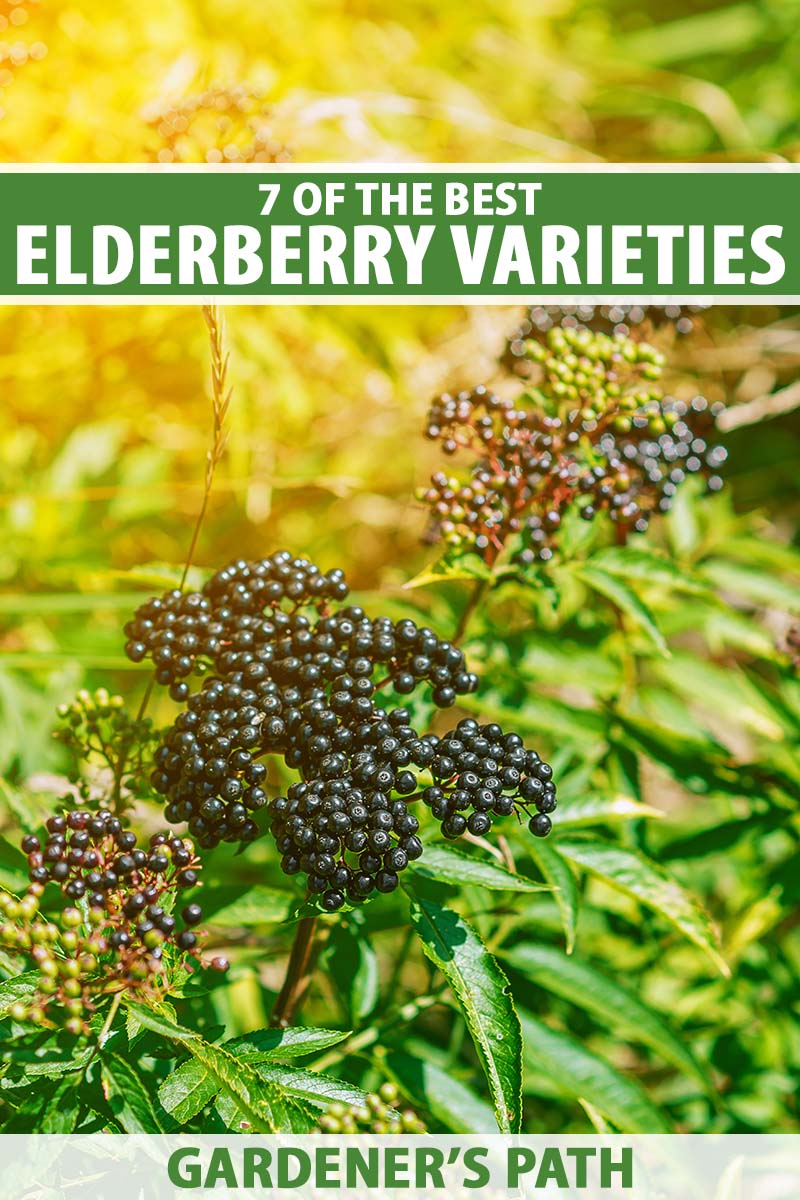
We link to vendors to help you find relevant products. If you buy from one of our links, we may earn a commission.
If you live in a growing zone that is pleasing to this shrub, I highly recommend giving elderberries a chance.
You can certainly propagate existing plants from cuttings or suckers – especially if you are fortunate to have them growing wild in your region. But many gardeners choose to buy proven varieties from nurseries and garden centers.
We’ve identified seven of our favorite cultivars for the home gardener to include:
Best Elderberry Varieties to Grow at Home
1. Adams
‘Adams’ is a cultivar of native Sambucus canadensis. It is one of the most common elderberries grown in North America and is similar to those found growing wild.
The signature white flowers, and large clusters of dark purple fruits, make it easily identifiable as a beautiful yard accent.
At full height, this beautiful bush can reach between six and 10 feet tall. It will thrive in USDA Hardiness Zones 3 to 9.
Find live plants for sale in #3 containers from Nature Hills Nursery.
Alternatively, you can purchase ‘Adams’ and ‘John’ planted together in a two-gallon container from Fast Growing Trees.
2. Black Beauty
An import from Europe, Black Beauty® aka S. nigra ‘Gerda,’ has very dark leaves, pinkish blooms, and a unique lemon scent.
It is best suited for growing in Zones 4 to 7 and prefers moist or even wet growing conditions.
A smaller elderberry variety, this plant will grow to no more than six feet tall at maturity, but responds well to pruning.
Like other elderberries, it produces luscious fruits that have become popular for making delicious wines. Buy two to ensure proper pollination.
You can find this plant for sale as a potted shrub from Nature Hills Nursery.
3. Black Lace
Black Lace® aka S. nigra ‘Eva’ has dark leaves that appear lacy throughout the growing season. When the flowers bloom, you’ll be delighted to find that they are pink!
This plant also produces the same versatile berries as other more common varietals.
Many gardeners find that the plant’s need for moisture makes it a perfect rain garden addition.
A bit smaller than other bushes, these plants will grow to just eight feet tall at full height. It’s easy to prune, so feel free to trim it to the height that works best with your landscape design plans.
Black Lace® thrives in Zones 4 to 7. It is available in #1 containers from Nature Hills Nursery.
4. Blue
S. cerulea is native to the western United States, Mexico, and the West Coast.
With large, powdery-blue berries, it can sometimes be confused for a form of blueberry. The fruits on this stunning bush are known for having a rich flavor.

This species differs from cultivated varieties in that it grows best from seed.
It thrives in warmer regions, and therefore is best suited for Zones 3 through 10. At maturity, it can reach a height of 10 to 30 feet, with a spread of 18 feet under ideal growing conditions.
Seeds for this unique plant are available from Amazon.
5. Instant Karma
S. nigra Instant Karma® features variegated green and white foliage and dark purple fruits, making it a beautiful yard accent.
Owners of the plant are usually stunned by how birds and pollinators are attracted to the large, showy white flowers. Butterflies are almost always nearby!

Plant with Black Lace® or Black Beauty® for pollination.
You can expect this variety to reach a mature height of six to eight feet. Instant Karma® is suitable for cultivation in Zones 4 to 7.
Find plants in quart-size containers available from Proven Winners via Amazon.
6. Lemony Lace
Lemony Lace®, S. racemosa ‘SMNSRD4,’ is a very hardy and showy plant that has feathery, light-colored leaves, and produces red fruits in the fall, after the white flower bunches have died away.
Amazingly deer-, cold-, and wind-resistant, it does well in full sun and is a prized plant in the northern United States. It’s versatile enough, however, to thrive in partial shade in southern states as well.
A smaller cultivar, this type typically attains a height and spread of three to five feet at maturity.
Plant in Zones 3 to 7 and enjoy this adaptable plant with its uniquely beautiful chartreuse color.
Please note that some experts caution against eating the fruits from S. racemosa cultivars, specifically those with red berries.
Lemony Lace® is available from Nature Hills Nursery in #3 containers.
7. York
Another S. canadensis cultivar, ‘York’ is reported to have the largest berries and the highest fruit yield.
This resilient breed is also cold tolerant, making it a perfect choice for Zones 3 to 9. Many growers use it as a natural fencing solution, since bushes can grow up to 12 feet tall.
Fall brings about a beautiful color change in this plant. Foliage becomes bright red before dropping off for the winter.
‘York’ is available as two- to three-feet bare roots or shrubs in #3 containers from Nature Hills Nursery.
Elderberry Collection, 2 Bare Root Plants
Though most varieties of elderberry are self-fruiting, you can encourage higher yields by planting another cultivar of the same species nearby.
‘York’ and ‘Adams’ make excellent companions, and you can purchase bare root plants paired conveniently in the Elderberry Collection that is available from Burpee.
Which Plant is Best?
With so many options to choose from, it may be difficult to decide on a favorite. Luckily, most elderberries grow well together, giving you the choice to try multiple types for a rainbow of florals.
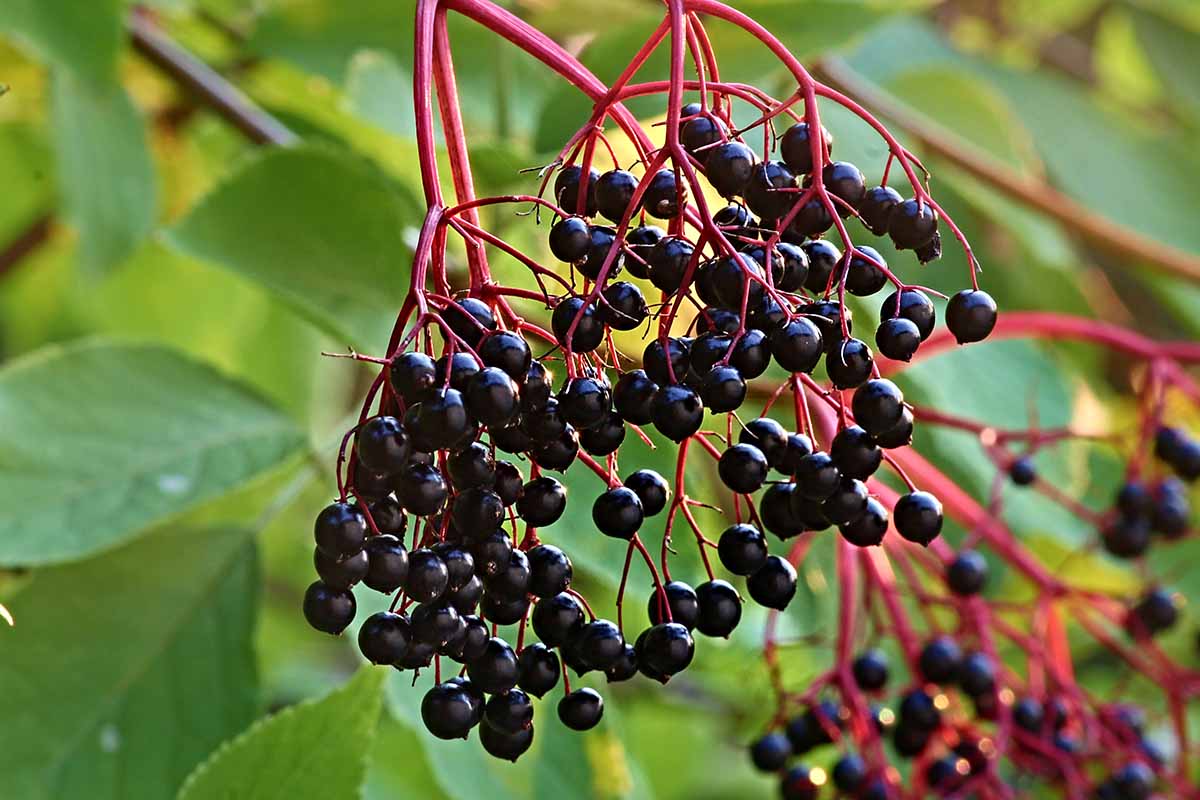
If it is your first time growing, you will likely do well with an established bush in a pot.
Remember that every breed thrives in moisture and works well in butterfly ecosystems. You can’t go wrong with the benefits that these varieties provide!
Which elderberry species or cultivar do you have experience growing? Do you prefer to choose by foliage, flower, or berry? Please leave your pick of the best in the comments!
And since we know that you’re an elderberry fan, be sure to check out our some of our other guides such as:


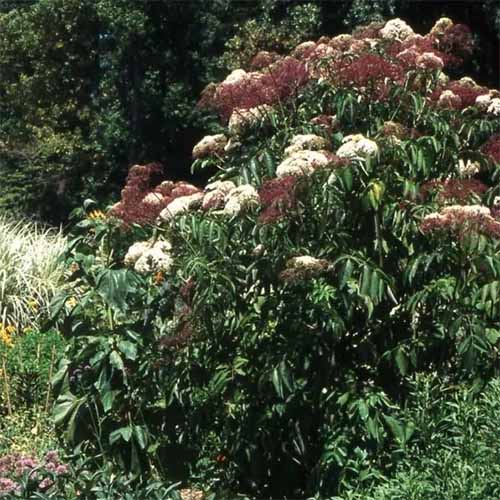
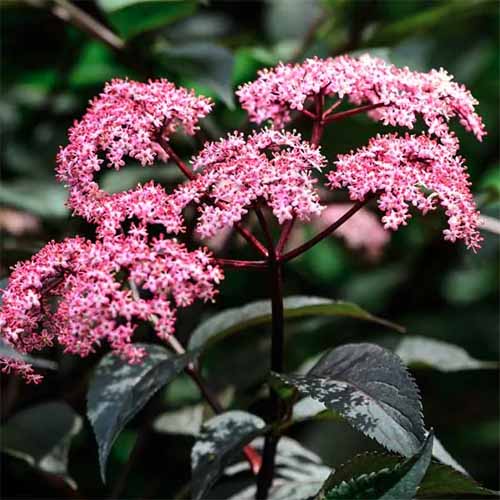
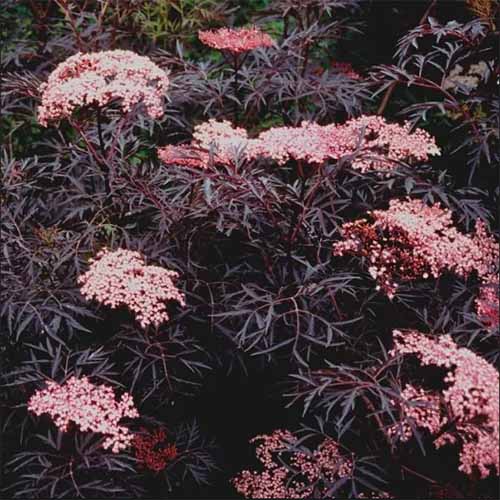
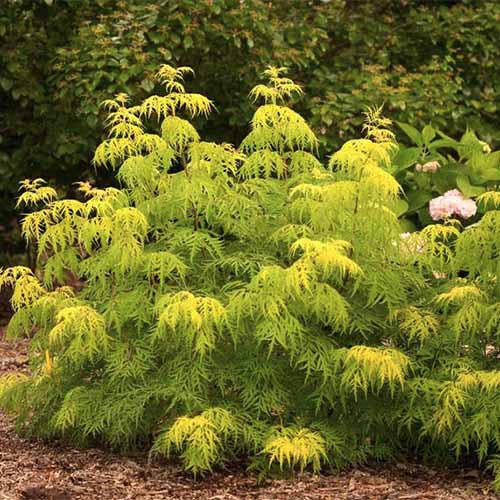
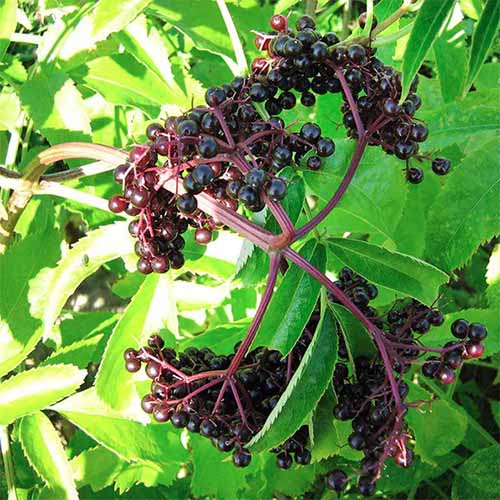
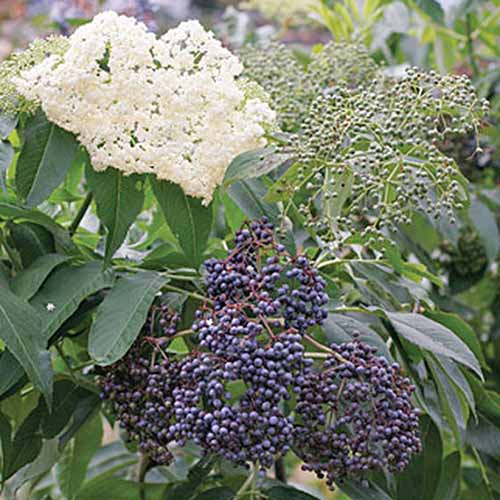
I grew up in northeastern Pennsylvania on wild elderberries. I now live in southeastern Arizona, a completely different growing zone, and I miss them! I want to cultivate a medicinal garden, and I would be so happy to find a variety that can grow in zone 8-9. Any suggestions?
Thanks for your question, Hannah. There are several types that will do well in your zone, including the Adams, Blue, and York cultivars. Good luck this season- let us know how adding them to your Arizona medicinal garden goes!
Hi, I also grew up in Penna. and on wild elderberries, to me its the best pie I have ever had… and like you we moved to the desert close to Golden Valley and Bullhead City. We have been trying to grow elderberries here… the first two years the sun and heat was and is brutal on the plant – no matter how much I watered, it wasn’t enough to develop fruit/berries. We have weeks of 100+ degree heat and the sun is also very damaging to the plants. This year we went to the extreme and built a shade… Read more »
Hi, Daniel— Wow, please post your Elderberry Pie Recipe– I haven’t been as intrigued by anything in quite a while! Thanks!!
I’d love to know about pie as well. Also, I love your determination.
Please post elderberry pie recipe.
Question- I live in Las Vegas Nevada, I want to grow elderberries and wonder if they will do well in this NEVADA heat followed by cold in the winter? What is the best variety to grow and is it better to plant them in shade or mostly sun?
Hi Emma, Well, let’s see… Las Vegas spans zones 9a to 8b, so you may be able to grow types that are tolerant of this climate, such as the ‘Adams’ or ‘York’ varieties – but it isn’t going to be easy. The winter will be manageable, since all cultivars that I know of are cold hardy, as long as proper irrigation is provided. It’s the daytime heat of the summer that will be your main concern. Salty and easily compacted soil are issues common to your area as well. Of course, taking on challenges and growing delicious produce as a… Read more »
Las Vegas winters won’t harm Elderberry Bushes. They survive the South Central and MidWest winters.
You must allow for plenty of water, they love ground moisture, so a drip system may not be enough.
Apricots grow extremely well in Las Vegas, I encourage you to plant and enjoy a bountiful harvest of Apricots.
I miss living there. Was my home for 17 years.
Best Wellbeing.
Do you share your recipe for elderberry pie?
They grow Mexican elderberry trees in Tucson AZ without shade. The trees defoliate in summer, (the dormant season for them) but keep their leaves the rest of the time and produce elderberries. Not sure how similar/different they are to more traditional elders in terms of medicinal qualities or how hardy they are, but they are related.
Sambucus mexicana it is drought deciduous. It grows well in our very hot inland areas of Southern California. They are a powdery blue berry. Be sure to process your berries thoroughly and throw away the green berries and the stems. They make the best syrup and can also be dried for tea. The flowers can also be dried for tea.
Would you mind sharing pie recipe ? I make syrup n jam
Thank you
western pa we used to pick them and make elderberry jelly
I want to grow elderberries to make syrups, jams, jellies and wines. I am located in Louisiana. Which plant would be best for these recipes?
Thanks for your question, Moranda! In Louisiana, you are likely located in USDA Hardiness Zone 8 or 9. The Adams and Blue varieties should do well, but the York is our favorite for canning and winemaking, since it offers prolific yields. Good luck, and happy gardening!
I live in CT – what type do you recommend me getting? Or what 2 different types for cross pollination? Thanks so much.
Hi Eileen. You’ll definitely help to ensure bigger harvests if you plant a few different types near each other. This is a great idea! Even though CT isn’t particularly large, you do have some variation in climate across the state, with growing zones stretching from 5b in the north to 7a in the south. Any elderberry cultivar should act as a good pollinator for other types. York and Adams do well together, and should produce nicely in your zone if given the right growing conditions. Planting cultivars with different maturation dates will also help to provide an ongoing harvest- and… Read more »
I live in Long Island, NY on the north shore and am dreaming about starting a medicinal garden in my backyard as well as purchasing a farm either upstate NY, western MA or PA to grow elderberries on a larger scale. Any advice on what varieties would do well in these areas? Thank you!
OK, so I live in Upstate SC and want to plant elderberry bushes. I have read about several of them. However, all of them except the “Common Elderberry” say they are a 2 year plant. Therefore I take it you could plant the Common Elderberry and any other variety and only have to re-plant one of them every other year. Do I have this correct? Which plants do you suggest for Spartanburg, SC?
Hi Wanda. Thanks for your question. Spartanburg is located in USDA Hardiness Zone 7b, or Zone 7a if you reside a bit outside the city and further to the north. And lucky for you, all of the varieties that we recommend in this article do well in this growing zone, as long as they have the right growing conditions! I’m not sure where you got the information about two-year or biennial plants. Elderberries are perennials that typically start producing fruit within 1-3 years of planting, and they will continue to produce for many years, given the right conditions. They are… Read more »
Hi Jaimee. Wow, this sounds fantastic! On the north shore of Long Island you’re in zone 7a, and all of the varieties that we recommend in this guide should do well there. I’d need more detail to know more specifically what growing zone you would be in depending on where your farming plans might take you- the USDA offers an excellent interactive hardiness zone map that you can search by zip code, and I recommend checking that out. To give you a rough idea, for update NY you’re probably looking at zones 3b-6a, depending on how far upstate you go.… Read more »
I read that the Red Elderberry that grows in the
lower Cascades here in Oregon is poisonous?
Thanks for your question, Frank! First and foremost, it’s important to proceed with caution when you’re considering eating any new or previously unknown foraged foods. The roots, bark, and leaves of the red elderberry are definitely poisonous, but the jury’s still out on the fruit itself – indigenous people of the Pacific Northwest harvested, processed, and ate these berries for countless generations, but on the other hand, some studies suggest that the seeds may contain toxic compounds. This is important, since the red variety is packed with seeds! Whether or not they’re actually poisonous, they’re not very palatable, and are… Read more »
My lemony lace elderberry came with a warning label not to eat the berries, which is not a problem as the birds are quick to get them anyway. Also, the deer nibble on the new growth in spring and summer. That being said, it is the prettiest addition to my garden, it practically glows.
Thanks for the feedback, Carol! We double checked, and you’re right- unlike the black lace (an S. nigra cultivar) which has black berries, the lemony lace cultivar is a cross between ‘Sutherland Gold’ and ‘Dropmore Fernleaf,’ both varieties of S. racemosa- or red elderberry. Though it’s up for debate whether or not these berries should be eaten (see our earlier reply to a question about the wild variety that grows in the Cascades), it’s always better to err on the side of caution if you are uncertain- and the birds do love them! As for enjoying the foliage, kudos to… Read more »
I have two Green Lace Elders, would they be okay to help with pollination for another higher yield type of Elder out here in SW Washington State?
In SW Washington you’re in Zone 8, and many varieties should do well there. I’m not familiar with the name ‘Green Lace’ – perhaps this could be the ‘Lemony Lace’ variety? This cultivar of S. racemosa doesn’t require another type for cross-pollination, and the red elderberries that this species produces don’t share the same qualities as black berry-producing types in terms of edible use – these are considered to be the most toxic of the Sambucus species. ‘Black Lace’ and ‘Sutherland Gold’ are other S. racemosa cultivars that might serve as good pollinators for the type that you’re growing. If… Read more »
Just realized I may have misinterpreted your question, Cynthia- if you’re asking whether this type can help to pollinate other higher-yielding varieties, this would depend on the species and bloom time.
Hi!
I love this article. I have been researching elderberries because I am trying to figure out if we can grow them in a narrow area (SE section) of our yard. I read it spreads by suckers. Can we control the spreading since the area we are planning to plant is really narrow? The area is 10 ft wide with a pathway so we can access the air conditioning unit that is situated there. We are in Raleigh, NC.
Thanks!
Ruby
Thanks for your question, Ruby! Elderberries do spread by suckers, though some varieties spread more readily than others, and this also depends on whether they have an ideal growing environment or not. Like any plant that spreads this way (such as lilacs), you’ll want to dig out the unwanted suckers once a year or so, and stay on top of this to prevent unwanted spread. Suckers that you dig up can be used to start new plants in another area of your garden, or you can share with a gardening friend! An area 10 feet wide may be a tight… Read more »
I’m considering trying to make cuttings of elderberries near me to plant as a hedge row on an often wet side of my driveway. Is there a particular variety to look for or buy for that kind of purpose, or will Adams & York do as well as any other? I mention them because I know they can be found in the area (Central Maine, Zone 4b). Cheers!
Hi Matthew. Thanks for your question! York and Adams make a great pairing, but York might not be the best choice for a hedge since it doesn’t grow as tall as other varieties. If height is what you’re after, European varieties (S. nigra) tend to grow the tallest in comparison to the American (S. canadensis) cultivars. Try ‘Beauty’ or ‘Black Lace’ if height is what you’re after. Otherwise, if you’re okay with maxing out around 6 or 12 feet, the average top heights at maturity for York and Adams respectively, these should do well in your area. Keep in mind… Read more »
I live in SE Kansas. What would be the best variety? We used elderberry syrup this year for the first time and would like to grow our own.
Hi Libby! It looks like you’re in growing zone 6a, so any of our recommended varieties will do well, given that your planting location provides the right conditions. Be sure to grow at least two plants to get the best harvest. Good luck, and enjoy the homemade syrup once your berries come in!
Hello, I live in Farmington, N.M., which I believe is zone 6 a. I’m looking for a bush or tree that will provide food and protection for birds. There are hawks in the area and I would like to offer birds a sanctuary here. I need something that grows at least 6 ft.and the foliage is dense. We are pretty dry here but I could supplement the area through irrigation. The trees are shaded in the morning but would have full sun in the afternoon. Do you think elderberries would be a good fit for my requirements? I was thinking… Read more »
Hi Sheron, thanks for your question. Many varieties will do well in your zone, and the S. negra species is known for its height in comparison to the American variety. But S. canadensis types like the Adams can also grow to fit your height requirements. If you’re able to plant another cultivar in addition to the Adams, you should do well with ensuring good cross-pollination. The birds will be thrilled! But keep in mind that they do prefer cool and moist but well-draining locations with some shade over anything hot and dry. With a good irrigation plan, this could work.… Read more »